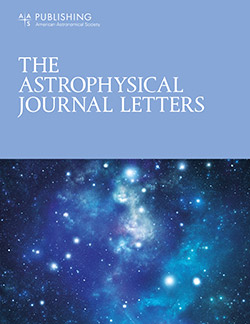辐照对毫秒脉冲星自旋的影响
IF 8.8
1区 物理与天体物理
Q1 ASTRONOMY & ASTROPHYSICS
引用次数: 0
摘要
毫秒脉冲星(MSP)是一颗古老的中子星(NS),它从伴星中吸积物质,导致其旋转,这被称为再循环情景。在传质阶段,系统表现为x射线双星。PSR J1402+13的自旋周期为5.89 ms,自旋周期导数为log P (spin) =−16.32。这些特性使它成为脉冲星群中一个值得注意的对象,因为msp通常表现出低自旋周期导数。在本文中,我们的目的是通过二元演化来解释MSP如何具有高自旋周期导数。利用恒星演化代码MESA,研究了双星演化过程中辐照对伴星的影响和螺旋桨对NS的影响。我们证明了辐照可以改变MSP的自旋周期和质量,从而导致更高的自旋周期导数。这些结果表明,辐照效应可能是解释具有高自旋周期衍生物的MSPs的关键因素。本文章由计算机程序翻译,如有差异,请以英文原文为准。
The Effect of Irradiation on the Spin of Millisecond Pulsars
Abstract A millisecond pulsar (MSP) is an old neutron star (NS) that has accreted material from its companion star, causing it to spin up, which is known as the recycling scenario. During the mass transfer phase, the system manifests itself as an X-ray binary. PSR J1402+13 is an MSP with a spin period of 5.89 ms and a spin period derivative of log P ̇ spin = − 16.32 . These properties make it a notable object within the pulsar population, as MSPs typically exhibit low spin period derivatives. In this paper, we aim to explain how an MSP can possess a high spin period derivative by binary evolution. By utilizing the stellar evolution code MESA , we examine the effects of irradiation on the companion star and the propeller effect on the NS during binary evolution. We demonstrate that irradiation can modify the spin period and mass of an MSP, resulting in a higher spin period derivative. These results suggest that the irradiation effect may serve as a key factor in explaining MSPs with high spin period derivatives.
求助全文
通过发布文献求助,成功后即可免费获取论文全文。
去求助
来源期刊

Astrophysical Journal Letters
ASTRONOMY & ASTROPHYSICS-
CiteScore
14.10
自引率
6.30%
发文量
513
审稿时长
2-3 weeks
期刊介绍:
The Astrophysical Journal Letters (ApJL) is widely regarded as the foremost journal for swiftly disseminating groundbreaking astronomical research. It focuses on concise reports that highlight pivotal advancements in the field of astrophysics. By prioritizing timeliness and the generation of immediate interest among researchers, ApJL showcases articles featuring novel discoveries and critical findings that have a profound effect on the scientific community. Moreover, ApJL ensures that published articles are comprehensive in their scope, presenting context that can be readily comprehensible to scientists who may not possess expertise in the specific disciplines covered.
 求助内容:
求助内容: 应助结果提醒方式:
应助结果提醒方式:


